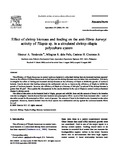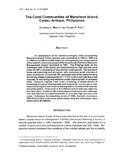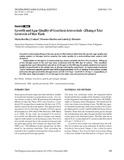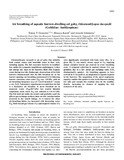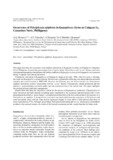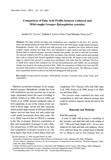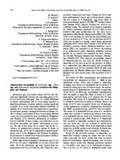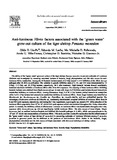Journal Articles: Recent submissions
Now showing items 401-420 of 1234
-
Are mangroves worth replanting? The direct economic benefits of a community-based reforestation project
(Cambridge University Press, 2006)Competition for coastal land use and overexploitation have reduced or degraded mangrove coverage throughout much of their distribution, especially in South-east Asia. Timber production was the initial motivation for early ... -
Presence of snapper, seabass, and siganid inhibits growth of luminous bacteria in a simulated shrimp culture system
(Elsevier, 2006)The antibacterial effect of the presence of Tilapia hornorum against luminous bacteria in shrimp culture has been reported. This study investigates how the presence of commercially valued marine species such as seabass, ... -
Effect of shrimp biomass and feeding on the anti-Vibrio harveyi activity of Tilapia sp. in a simulated shrimp–tilapia polyculture system
(Elsevier, 2006)The efficiency of Tilapia hornorum to control luminous bacteria in a simulated shrimp farm environment has been reported. However, the effects of different factors such as feed input and the shrimp biomass were not taken ... -
Price relationships in Philippine milkfish markets: Univariate and causality analysis
(International Association of Aquaculture Economics and Management (IAAEM), 2006)Uncertainties and lack of information on milkfish product prices, along with production-related problems with inputs, generally constrain efficient resource use in milkfish grow-out operations. Milkfish growers complain ... -
Hatchery-produced milkfish (Chanos chanos) fry should be fed docosahexaenoic acid-enriched live food: A case of the difficulty in the transfer of improved aquaculture technology in the Philippines
(Ministry of Tropical Agricultural Research Centre, 2006)Levels of highly-unsaturated fatty acids, the most important nutritional factors in fry production of marine fish, were compared between hatchery-produced and wild-caught milkfish Chanos chanos fry. The most striking ... -
Microsatellite–centromere mapping in the Japanese eel (Anguilla japonica) by half-tetrad analysis using induced triploid families
(Elsevier, 2006)Genetic improvement of the Japanese eel (Anguilla japonica) can be achieved by artificially controlling its life cycle using recent advances in reproductive biology. In this study, we developed 43 microsatellite loci to ... -
The coral communities of Mararison Island, Culasi, Antique, Philippines
(University of the Philippines in the Visayas, 2006)An assessment of the extensive fringing reefs surrounding Mararison lsland, Culasi, Antique was undertaken in 1994 to 1996 and in 1998 to provide scientific basis for management and enhancement of the island s resources ... -
Growth and agar quality of Gracilaria heteroclada (Zhang et Xia) grown in a filter tank
(College of Agriculture, University of the Philippines Los Baños, 2006)Gracilaria heteroclada Zhang et Xia was grown in filter tanks to determine the growth, agar quality and uptake pattern of nitrogen and to observe the water quality in recirculating water system with seaweed. Rapid uptake ... -
Air breathing of aquatic burrow-dwelling eel goby, Odontamblyopus lacepedii (Gobiidae: Amblyopinae)
(Company of Biologists, 2006)Odontamblyopus lacepedii is an eel goby that inhabits both coastal waters and intertidal zones in East Asia, including Japan. The fish excavates burrows in mudflats but, unlike the sympatric amphibious mudskippers, it does ... -
Immunolocalisation of nervous necrosis virus indicates vertical transmission in hatchery produced Asian sea bass (Lates calcarifer Bloch)—A case study
(Elsevier, 2006)A probable vertical mode of piscine nodavirus transmission is reported in the present investigation based on a case of nodavirus associated larval mortalities in hatchery produced Asian sea bass. Polyclonal rabbit anti-SJNNV ... -
Occurrence of Polysiphonia epiphytes in Kappaphycus farms at Calaguas Is., Camarines Norte, Phillippines
(Springer Verlag, 2006)This paper describes the occurrence of an epiphyte infestation of Kappaphycus farms in Calaguas Is. Camarines Norte, Philippines. In particular, percentage cover of ‘goose bump’-Polysiphonia and ‘ice-ice’ disease, and some ... -
Comparison of fatty acid profile between cultured and wild-caught grouper Epinephelus coioides
(Japan Aquaculture Society, 2005)The lipid content and fatty acid composition were examined in the liver, eye, muscle, brain and intraperitoneal fat body (IPF) of hatchery-bred and wild-caught orange-spotted grouper, Epinephelus coioides. The cultured and ... -
Efficiency of Chlorella sp. and Tilapia hornorum in controlling the growth of luminous bacteria in a simulated shrimp culture environment
(Elsevier, 2005)This study clarifies the effect of green water from Chlorella sp., Tilapia hornorum and the combination of the two organisms on the growth of luminous bacteria in a simulated shrimp culture environment. Results showed that ... -
Seabream GnRH: partial cDNA cloning, localization and stage-dependent expression in the ovary of snake head murrel, Channa striatus
(Springer Verlag, 2005)Vertebrate reproduction is under the neuroendocrine control of the hypothalamic decapeptide GnRH which synchronizes various reproductive events and influences other reproduction related aspects like spawning behavior and ... -
Genetic changes during mass selection for growth in Nile tilapia, Oreochromis niloticus (L.), assessed by microsatellites
(Blackwell Publishing, 2005)Two control (C1 or first control generation, and C4 or fourth control generation) and three selected (S1 or first selected generation, S2 or second selected generation, S4 or fourth selected generation) stocks of Chitralada ... -
Proposed activities for koi herpesvirus disease at the SEAFDEC Aquaculture Department
(Fisheries Research Agency, 2005)The Southeast Asian Fisheries Development Center (SEAFDEC) is a regional treaty organization with 11 member countries. This was established in 1967 to promote fisheries development in Southeast Asia. As one of four SEAFDEC ... -
Antimicrobial susceptibility of Aeromonas spp., Vibrio spp. and Plesiomonas shigelloides isolated in the Philippines and Thailand
(International Society of Chemotherapy, 2005)Aeromonas spp., non-cholera vibrios (NCVs) and Plesiomonas shigelloides belong to the expanding group of water and food-borne pathogens. They are widely distributed in aquatic environments and are increasingly regarded as ... -
A preliminary summary on Kappaphycus farming and the impact of epiphytes
(Japanese Society of Phycology, 2004)The read seaweed Kappaphycus alvarezii (Doty) Doty ex. P.C. Silva, commonly called "cottonii" in the processing industry, is used as raw material for the production of the hydrocolloid kappa carrageenan. Through biotechnological ... -
Anti-luminous Vibrio factors associated with the ‘green water’ grow-out culture of the tiger shrimp Penaeus monodon
(Elsevier, 2005)The ability of the “green water” grow-out culture of the tiger shrimp Penaeus monodon to prevent outbreaks of Luminous Vibriosis was investigated by screening associated isolates of bacteria, fungi, phytoplankton and fish ... -
Sea lice (Copepoda, Caligidae) parasitic on marine cultured and wild fishes of the Philippines
(The Fisheries Society of Taiwan, 2004)Four species of sea lice were found parasitic on ten species of marine fishes either cultured in the coastal ponds or occurring in the sea water supply canals in the Philippines. They are: Caligus epidemicus Hewitt, 1971 ...




